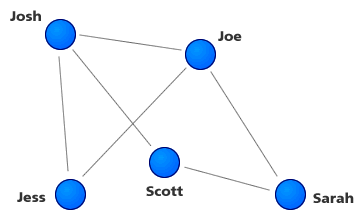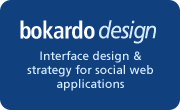September 19th
Netflix in danger of ruining their user experience
Or, the moment when Netflix jumped the shark.
Continue Reading: Netflix in danger of ruining their user experience
TAG: Netflix
September 19th
Or, the moment when Netflix jumped the shark.
Continue Reading: Netflix in danger of ruining their user experience
September 11th
Why our relationships can’t be explained without the objects and experiences that we share.
One of the biggest problems on the Web is joining a new social networking site. To do so means going through the painful effort of creating a profile and adding all of our friends, something we’ve done over and over…at least once for each social networking site we already belong to. This is quickly becoming an issue for everyone who uses social networks.
This problem has led to a flurry of activity, highlighted by LiveJournal creator Brad Fitzpatrick’s missive: Thoughts on the Social Graph, in which he clearly outlines the issues involved as well as some worthy goals to shoot for. Brad’s piece was followed shortly after by the Bill of Rights for Users of the Social Web, which among its rights is the right to allow users to syndicate their own profile and friend data. This, of course, would alleviate the squeaky wheel.

In addition there are countless groups getting together to try and solve this problem. The microformats folks are working on building formats to help with this. The DataSharingSummit is an entire event focused on this and related problems. All of this activity is centered around one idea: that people have a social graph that can be represented in software. In other words, we can recreate our offline relationships online and let everyone know about it by sharing some sort of file or feed.
The major axis of the social graph, as Fitzpatrick points out, is relationships between people, or more simply, a list of friends. My social graph, for example, consists of my friends, colleagues, family, and acquaintances. These people I know to some extent or another, some I talk with daily, some I know only online, and some I would rather not speak to. 🙂
Continue Reading: The Social Graph and Objects of Sociality
August 9th
While I’m hurriedly working on building out a corporate site for Bokardo Design, I thought I would take a minute and share a little background which led me to starting the company and what services I’m offering.
Many of you know that I worked at User Interface Engineering for 5 years. It was definitely the best and most exciting job I’ve ever had; Jared and the team are fantastic. While I am super excited about what I’m doing now, I am sorry to leave such a unique and wonderful place. Even so, I won’t be leaving UIE completely…we’re still collaborating on several projects and will continue to do so where appropriate.

When I was at UIE I did a mix of usability consulting and web design. Usability consulting for UIE clients and in-house web design and development for UIE itself. So I basically alternated between consulting and designing. In hindsight this afforded me an excellent opportunity to understand the design problem from both sides of the fence: from the view of an objective 3rd party consultant as well as from the standpoint of an in-the-trenches designer. These worlds are incredibly different, and both are unique in their own way.
Continue Reading: Why I started Bokardo Design
July 24th
One of the emerging principles of social design is what I call The Del.icio.us Lesson, which can be summarized as “personal value precedes network value”. Since I wrote about the Del.icio.us Lesson last year, it has become one of my most read and cited posts.
Other evidence would suggest that there’s something to it as well, that it is indeed a strong principle that helps us build better social software. Several of the social design folks that I regularly read, including Thomas Vander Wal and Rashmi Sinha, have observed similar phenomena. In a talk she gave about social design at Wordcamp, Rashmi’s first principle was “Make the system personally useful”. You can see her slides here.
Now, it’s one thing to talk about the importance of personal value and how that personal value precedes network value, but just what does the Del.icio.us Lesson mean in practice? That’s what this series of posts is about…
Continue Reading: Putting the Del.icio.us Lesson into Practice, Part I: The Cold-Start Problem
July 15th
Netflix.com is one of my favorite sites, both for the valuable service they provide but also because they do really great web application work. From the Netflix Community Blog:
Question: “If we KNOW something is a feature you want, or a feature we want, why isn’t it on the site already — or why is it taking so long to release?”
Continue Reading: Why is the Netflix Site Good?
July 11th
This is part III of a series on Common Pitfalls of Building Social Web Applications. Read Part I and Part II
Thoughtful recommendations are the best possible way to increase your user base. It is word-of-mouth in action. When someone takes time out of their day to say something really nice about your service, making an honest-to-goodness recommendation, you will definitely see positive results. The question is, are you making it easy for your users to recommend you?
In our world lots of people make recommendations, but many of them are paid to do so or are looking after their own interests. Take, for example, the Publisher’s book descriptions on Amazon.com. These are always super-positive…they explain why the book is so great and why you should buy it. They would never contain anything negative, never contain anything that might potentially hurt the sales of the book.
And, as a result, the book description tells us exactly what we would expect from a publisher. To Amazon’s credit, they have over time given individual reviews and ratings more prominence on the product page, signaling that that content is more valuable to users. And of course it should be…those people aren’t biased in the way the publishing house is.
 Many sites add incentives for recommendations so that people give them more freely. Netflix, for example, allows you to give “free movies” to friends while you tell them about the service. This is a good approach. Netflix does not reward you for this…the act of giving is all that you get. If Netflix did give you a free movie that would introduce too much bias…and while more people might make recommendations it would quickly turn into a case similar to the publishers…as people would realize that there is something in it for the recommender.
Many sites add incentives for recommendations so that people give them more freely. Netflix, for example, allows you to give “free movies” to friends while you tell them about the service. This is a good approach. Netflix does not reward you for this…the act of giving is all that you get. If Netflix did give you a free movie that would introduce too much bias…and while more people might make recommendations it would quickly turn into a case similar to the publishers…as people would realize that there is something in it for the recommender.
Continue Reading: Common Pitfalls of Building Social Web Applications and How to Avoid Them, Part 3
July 9th
The Netflix team has a blog: Netflix Community Blog (via Sarah)
 The blog is interesting for several reasons, most notably the candidness of the posts. In this post on Movie Privacy, for example, the team talks about a new feature whereby you can mark movies private, so as to not show them to your friends. Michael writes:
The blog is interesting for several reasons, most notably the candidness of the posts. In this post on Movie Privacy, for example, the team talks about a new feature whereby you can mark movies private, so as to not show them to your friends. Michael writes:
“So, in a rather unNetflix-like way, we’re just going to release it to Friends users in the next week or so. Let’s see if this finally allows you to connect to folks you know slightly less well (or maybe too well), and for whom you absolutely needed the ability to hide some titles. We’ve all read your comments and suggestions for how best to implement this. Trust me: this isn’t that. It’s not that we’re not hearing your suggestions, it’s just i was interested in getting this in front of you quickly.”
This is really cool! Michael is obviously taking on a community manager type role here, announcing new features and asking for feedback. Saying that their new feature isn’t even the one that users were asking for is pretty interesting, too…how many design teams would do that?
Continue Reading: Netflix is Designing with Community Input
September 7th
Social software has been around for a long time. Email, after all, is the canonical example. But it’s been only recently that web designers as a whole have embraced it and really started innovating. We’ve got social news aggregators, social encyclopedias, social bookmarking, social networking, recommendation systems, social tagging…all of these things add up to huge changes in the way we use the Web. Though some folks see it as nothing more than social networking, there are elements of social software being built into most software today.
Who: Social software helps people by modeling their social lives online.
What: Social software is software that supports social activities.
Where: Social software is nearly everywhere.
When: Now.
Why: Social software is important because that’s the way that software is trending.
Continue Reading: The 5 W’s of Social Software
February 22nd
Here’s the slide deck for a talk I gave on Web 2.0 for the Greater Boston Chapter of the ACM, a non-profit educational and scientific society of computer professionals in the Boston area.
Web 2.0 – Leveraging the Network (2.74 MB pdf)
In the talk I spoke about how Web 2.0 companies distinguish themselves by leveraging the network of which they are a part. Brittanica, for example, has had a web site for quite some time and were slow to leverage the network in any particular way. Wikipedia, on the other hand, exists only because they used the available network to improve their contents communally. And Wikipedia, of course, is a much, much more popular site.
Continue Reading: Web 2.0 Talk – Leveraging the Network
February 1st
The most important statistic on the Web in the last year is the one delivered in a NYTimes article last week: Like This? You’ll Hate That. (Not All Web Recommendations Are Welcome.) [behind paywall 🙁 ]. The statistic involves media, technology, and the ever-increasing burden on our collective attention.
Here it is: 2/3 of Netflix rentals come from recommendations.
Continue Reading: The Most Important Statistic of them All